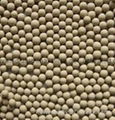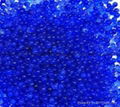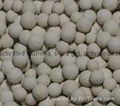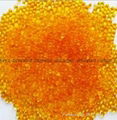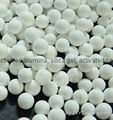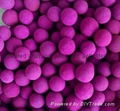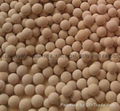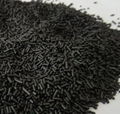| Model: | AC |
|---|---|
| Brand: | YUANYING |
| Origin: | Made In China |
| Category: | Chemicals / Chemical Auxiliary & Catalyst / Desiccant & Sorbent |
| Label: | Activated Carbon , carbon , carbon factory |
| Price: |
¥900
/ ton
|
| Min. Order: | 5 ton |
| Last Online:13 Apr, 2015 |
Yuanying activated carbon has high mechanical strength, quick adsorption speed, big adsorption capacity, large specific surface area, rich pore structure, strong decolorization capacity, special electronic properties, easy to regulate surface groups, strong acid-resistant, alkali-resistant and heat-resistant properties。
According to user’s requirements, different production methods are applied such as chemical method, physical method, chemical-physical or physical-chemical method.
The most common use of activated carbon is air purification, water treatment, catalyst carrier.
Air Purification Activated Carbon is made of wood, coal or coconut shell, granular or cylindrical appearance. For air purification, the best is coconut shell. It can efficaciously adsorb methanol, ammonia, radon, benzene, xylene, exhaust gas, lampblack, especially aromatic compound.
The raw materials of water treatment activated carbon have coconut shells, walnut shell, apricot, peach shell, wood, coal and so on, the coconut shell activated carbon is considered the best water treatment activated carbon. Water treatment activated carbon has powder, granule and columnar, among them granule is the most widely used. The smaller granularity, the faster absorption, but head loss increases, usually in 8-30 mesh is better.
Activated carbon as catalyst carrier, also can be directly as catalyst. As a carrier, mainly used to support catalyst, lets catalyst load on its surface and makes it possess certain physical and chemical property, carrier itself generally does not have catalytic activity.
Air Purification Activated Carbon
The structure of air purification activated carbon is relatively complicated, composed of planar layer of arranging in hexagonal carbon atoms, these planes are not arranged entirely along the common vertical axis, but layer and layer with an angular displacement, is messy and irregular, such a structure called the "whorl like structure". In the process of activation, all kinds of carbon compounds and disordered carbon between basic microcrystalline are cleared, created a space, the accumulations of remaining carbon are quite loose, but the mutual coupling is quite strong.Therefore between crystallite have many spaces with different shape, size and certain strength. According to the aperture size these spaces are generally divided into big pore, mid-hole and micropore. 90% specific surface area of activated carbon comes from micropore, its specific surface area can reach more than 1000m2/g, and pore volume also is large, so micropore is an important factor decided adsorption performance of air purification activated carbon.
The adsorption characteristics of activated carbon depend on its pore structures and the surface chemical properties, and surface chemical properties determine the chemical adsorption of active carbon. Activated carbon for gas adsorption includes physical adsorption and chemical adsorption, generally both been accompanied by simultaneous. Physical adsorption simply via attractive forces between molecules adsorbs adsorbate on the surface of the adsorbent. Physical adsorption is reversible, reducing adsorbent partial pressure in the gas phase, increasing the adsorption temperature, adsorbent quickly desorption, without changing its chemical composition. Chemical absorption has high selectivity, and a kind of adsorbent only has the effect to the specific substance. Chemical adsorption is irreversible, after adsorption adsorbent has changed the original characteristics.
Air purification activated carbon has big specific surface area, abundant pore structure, high mechanical strength, strong adsorption capacity, easy regeneration. It can efficaciously adsorb methanol, ammonia, radon, benzene, xylene, exhaust gas, lampblack, especially aromatic compound.
Widely used for purification of carbon dioxide, hydrogen, nitrogen, chlorine hydride, ethyne, ethylene, cracking gas, inert gases, atomic equipment; As the packing of antigas mask, poison gas filter; For dropping off air pollutants and classification purification of mixed gas.
Water Treatment Activated Carbon
Products are currently used for water treatment have activated carbon, silicon oxide, activated alumina, zeolite, diatomite and ion-exchange resins. The aluminum - silicone sorbents are hydrophilic adsorbent, they are selective adsorption to polar substances, so generally as the moisture absorption agent, dehydrant and nonpolar solution adsorbent. Activated carbon is a hydrophobic adsorbent, has strong adsorption to the organic compounds in aqueous solution, so generally as the city sewage and industrial wastewater treatment adsorbents.
The raw materials of water treatment activated carbon have coconut shells, walnut shell, apricot, peach shell, wood, coal and so on, the coconut shell activated carbon is considered the best water treatment activated carbon. Water treatment activated carbon has powder, granule and columnar, among them granule is the most widely used. The smaller granularity, the faster absorption, but head loss increases, usually in 8-30 mesh is better.
Yuanying water treatment activated carbon has three merits: large adsorption capacity, quick adsorption rate, good mechanical strength. In addition, activated carbon has large specific surface area, abundant pore structure, not easy off powder, low base layer resistance, chemical stability, high degree of purification, long service life, easy regeneration.
The main influencing factors to water treatment process of activated carbon
Due to the adsorption process and action principle of activated carbon water treatment involves more complex, so there are a lot of influence factors. The main factors include the properties of activated carbon, pollutants properties in water, solution PH, solution temperature, carbon treatment process principle, selective operating parameters and operating conditions.
Activated carbon adsorption capacity is mainly related to its specific surface area, the greater specific surface area is, the better adsorption property is. Adsorption rate is mainly related to grain size and pores distribution of activated carbon. Water treatment activated carbon requires abundant transition hole (radius is 20 to 1000 angstroms), that is conducive to the adsorbate (pollutants in water) spreads to the hole. In addition, activated carbon surface chemical properties, polarity and electric charge also affect the adsorption effect.
Application
Activated carbon surface has a large number of functional groups such as hydroxyl and carboxyl, can undertake chemical adsorption and electrostatic attraction to various organic substances. Activated carbon can remove the organic substances such as humic acid, fulvie acid, lignosulfonic acid etc. which are harmful to anion exchange agent; also can remove the substances such as free chlorine residual which is harmful to cation exchanger. Generally, activated carbon can remove 63%-68% colloidal substances, around 50% ferrum, 47%-60% organic substances. Activated carbon has strong adsorption capacity to water dissolved organic contaminants, such as benzenes, phenols, petroleum and petroleum products. Organic pollutants by biological method and chemical method is difficult to remove, such as chrominance, foreign odor, methylene blue surface active substances, herbicides, pesticides, agricultural chemicals, synthetic detergents, synthetic dyes, amine compounds, and many synthetic organic compounds, activated carbon have good effect to removal them. Activated carbon has strong adsorption capacity to some heavy metal compounds, such as mercury, plumbum, ferrum, nickel, chromium, zinc, cobalt, etc., therefore, activated carbon has a good effect to electroplating wastewater and treatment smelting wastewater treatment. Activated carbon is widely used for domestic water and food industry, chemical industry, electric power industry, etc. for water purification, dechlorination, oil removal and deodorization.
Activated Carbon Catalyst Carrier
One of important application of Activated Carbon is as catalyst Carrier and promoter, also can be directly as catalyst. As a carrier, mainly used to support catalyst, lets catalyst load on its surface and makes it possess certain physical and chemical property, carrier itself generally does not have catalytic activity. Common carriers include activated alumina, activated carbon, molecular sieves, clay, honeycomb ceramics, monox, kaolin, diatomite, etc. Usually used “active component-carrier name” to indicate supported catalyst composition, for example, Pd-activated carbon catalyst for hydrogenation, Pt-honeycomb ceramics catalyst for automotive exhaust purification.
Activated carbon impregnated with metal salts solution can make the catalyst load on the surface of activated carbon, activated carbon’s surface oxidation, acidic functional groups, electron accepting ability, free radicals, pore structure, chemical structure can affect the performance of the active component.
Activated carbon has the irregular graphite structure, in which includes traces of ash, nitrogen, sulfur, hydrogen, oxygen and so on, these ingredients can have the influence to the catalyst performance; Ash is an important indicator of support activated carbon; C-O structure on the surface of activated carbon will affect oxidizing reaction, halogenating response, adsorption performance and electricity performance.
Due to activated carbon has abundant pore structure, special electronic properties, easy to regulate surface groups, high specific surface area, strong acid-resistant, alkali-resistant and heat-resistant properties, when used as a catalyst carrier, the precursor of active component is fully dispersed. Activated carbon itself has catalytic activity, interaction with active component can affect the activity and selectivity of the catalyst, and can save the quantity of active substance. Compare with using metal alone, when activated carbon carriers trace amounts of transition metals, hydrogen shows obvious reversible adsorption phenomenon, this called overflow spillover phenomenon.
Activated carbon includes powder and granule, in the process of gas-solid reaction, all used granule activated carbon as catalyst carrier. Although activated carbon’s specific surface area is very high, but compare with activated alumina carrier, honeycomb ceramics carrier and molecular sieve carrier, its mechanical strength is lower. Therefore, in the production process, commonly activated carbon’s strength is controlled above 95%.
Precious metal catalyst includes Pd catalyst, Ru catalyst, rhodium catalyst, Pt catalyst, etc. As precious metal support, activated carbon shape can be powder, cylinder, sphere and granule.
The application of Yuanying activated carbon:
(1) Isomerization: Ni-Carbon catalyst can let plant oil isomerization (cottonseed oil, linseed oil, rapeseed oil, etc.), from non-conjugated oil into conjugated forms;
(2) Hydrogenation, dehydrogenation and dehydrogenation of aromatization, cyclization and isomerization: Pd-activated carbon catalyst or Pt-activated carbon catalyst can play this catalytic role;
(3) Low pressure polymerization of olefins: Activated carbon loads on Ni, Co or their oxide can let olefin polymerization;
(4) Synthetic fibre: In the production of vinylon, activated carbon impregnated zinc acetate can let acetylene and acetic acid synthetise vinyl acetate;
(5) Gum Rosin reprocessing: Activated carbon loads on Pd can produce hydrogenated rosin and disproportionated rosin;
(6) Synthesis of vinyl chloride: Activated carbon loads on mercuric chloride can let acetylene and hydrogen chloride synthetise vinyl chloride.
| Payment Terms: | TT |
|---|---|
